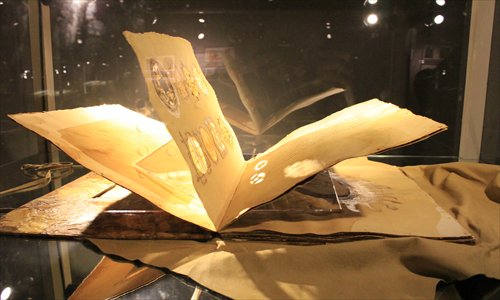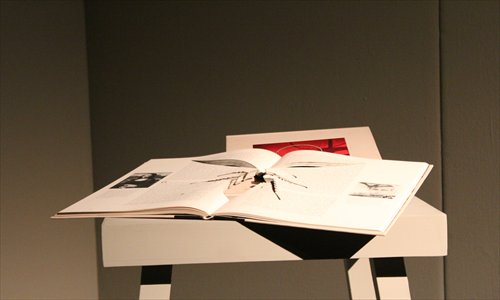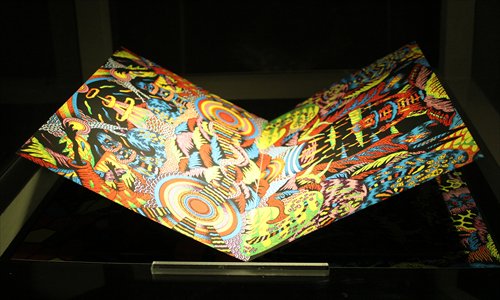Books of Art



Artist books featured at CAFA's "Diamond Leaves" Photos: Xu Ming/GT
A current exhibition at the Central Academy of Fine Arts (CAFA) Art Museum is wholly devoted to books, though most are not for reading. The featured works, known as artist books, are plainly works of art whose relation to traditional books is drawn only from form, not function.
Artist books, works of art that take the shape of books, first appeared in the West over a century ago. The genre was introduced into China around the 1980s, which saw several Chinese artists creating contemporary works of this type.
Marshall Weber, one of the exhibition's curators and directing curator of Booklyn Artists Alliance (BAA), told the Global Times that in a country with a long history of bookmaking and publishing, Chinese artist bookmakers have immense potential to become a creative global force in the future.
Unprecedented event
CAFA's "Diamond Leaves" is the first major exhibition of contemporary-style artist books to be held in an Asian museum, introducing the form to many students, art professors and influential artists. Co-sponsored by CAFA, the BAA and Artron Enterprises, Ltd, the show spans a century of artist books, ranging from 1912 to the present day, with a focus on works by emerging, young contemporary artists. The international exhibition, which will run through October 28, boasts over 100 works from China and the West, including countries like the US, the UK, Australia and Germany.
The show displays works by Franz Kafka, Marcel Duchamp, Andy Warhol, Kiki Smith and Chuck Close to provide a background to the current state of the genre. Contemporary Chinese works, such as Xu Bing's Book from the Sky and Chen Qi's The Trace of Time, are heavy with Chinese characteristics while embracing an experimental spirit through a variety of shapes and materials such as wood, cloth and tree bark.
Xu Bing, the other curator of the exhibition and deputy director of CAFA, said that in addition to providing an extraordinary visual tour, the show aims to demonstrate the global development of artist books over the past 30 years, with an emphasis on the huge expressive force of this genre in the art world.
At the exhibition's opening ceremony on September 18, Xu told the audience that these books are evolving from representing art to artistic representation. This new role of books within art is the result of artists participating in the creation of books, instead of simply providing the content, he said.
Exploring possibilities
Artist books first appeared in the last century and have gradually matured in several Western countries. Avant-garde writers and artists such as Kafka, Duchamp and Salvador Dali created their own works by hand, usually in limited batches or with only one copy.
The first artist books are thought to have been created by British poet William Blake and his wife Catherine, who together illustrated, printed and bound unique books by hand. This early integration of words, images and self-publication set the tone for future artist books.
The experience of taking in an artist book is a combination of reading, visual appreciation and tactile sensation. Such works are a vessel for artists to design and create imaginative bound volumes, often defying traditional notions of what defines a book. Many artist books extend the process of bookmaking by creating all kinds of artistic twists in the materials, content and shapes of books.
For example, in Para-schwarte, artist Micha Brendel used animal skin, organ tissues, paper and letterpressing to form a three-dimensional book with various patterns. In Axi Fire Festival, a work by Colette Fu, the artist took photos of 30 tribal communities in southern China and produced a dynamic pop-up book to show the life of the region.
These books, either laid flat, hung along the wall or appearing in the form of three-dimensional cubist paintings, demonstrate the immense artistic potential of books. What's more, they remind viewers of the irreplaceable nature of physical books.
In the era of the Internet, more people are reading digital books and communicating via e-mail rather than on paper.
"In this environment, artist books have room to develop, because they carry people's nostalgic feelings for books through history," said Xu.
Artist Chen Qi said that artist books are proof that physical books will not vanish anytime soon. "Many artists are still creating works of art in the form of books. This reflects people's deep connection to books."
Chinese influence
"Diamond Leaves" took eight years to plan, with its organizers determined to put a spotlight on the state of the art in China. Weber told the Global Times that over the last decade, Chinese artists have been developing a hybrid of Chinese and Western bookmaking traditions.
"China has a long history of bookmaking and publishing. Now, as Chinese explore their relationship with the rest of the world and the possibilities of their own increasing intellectual and artistic freedoms, they have immense potential to unleash magnificent creative forces," he told the Global Times in an e-mail.
In Book from the Sky, Xu created thousands of new Chinese characters and carved them by hand to explore the essence of Chinese culture and modes of thinking through these symbols.
Qi's The Trace of Time comprises several bound volumes of blank paper, into which the artist carved curvaceous holes that resemble the destruction that woodworms unleash on books.
Weber said he believes that Chinese artists are particularly well positioned to combine traditional and contemporary art of both China and the West to create more groundbreaking works. He also noted that while few Chinese artists are currently engaged in this genre, with time it is very likely that the form will become more popular.
At a roundtable meeting related to the exhibition, Xu also expressed his optimism for China's place in the world of artist books.
"China has a unique culture and tradition of making books, which provides special nourishment for Chinese artists to improve the quality of artist books and further develop the art form," he said.